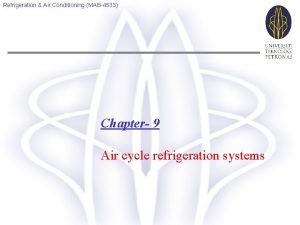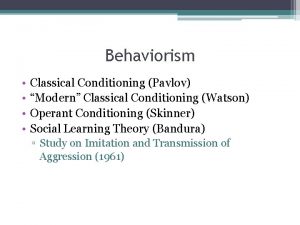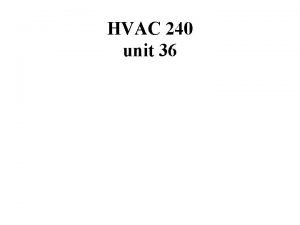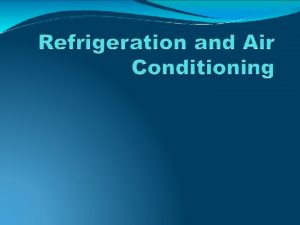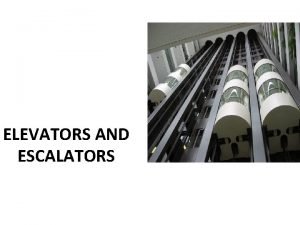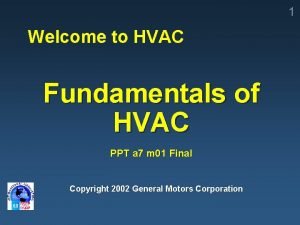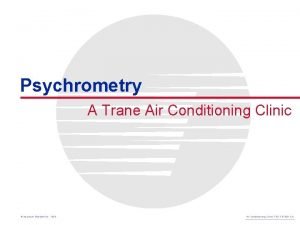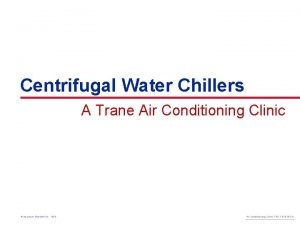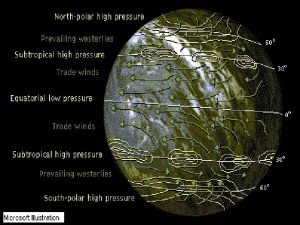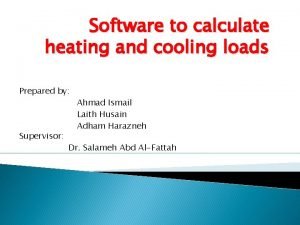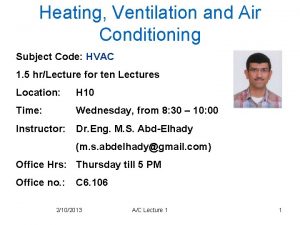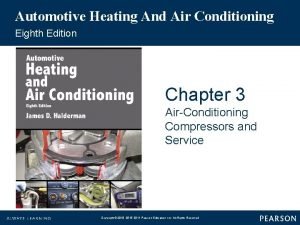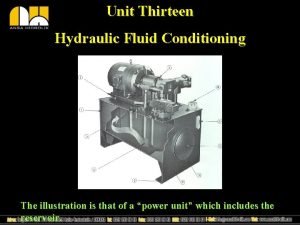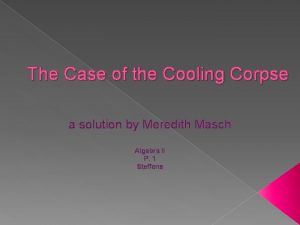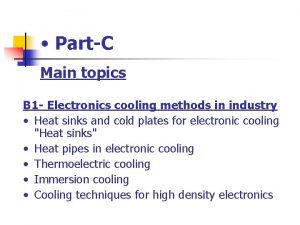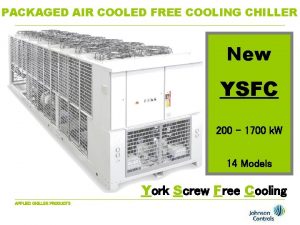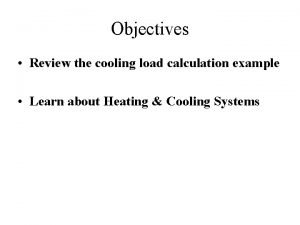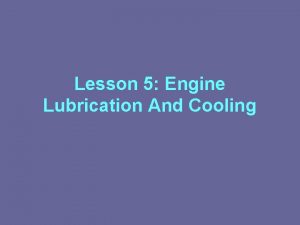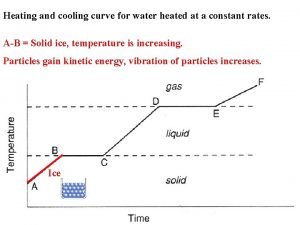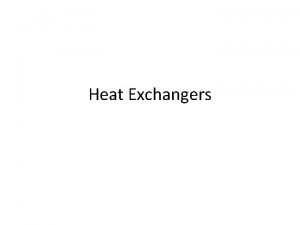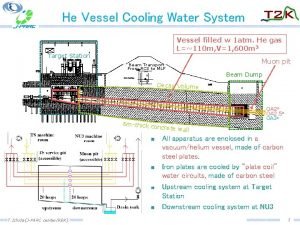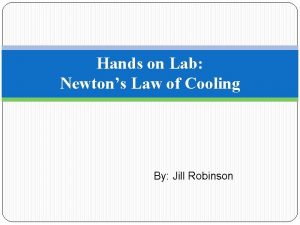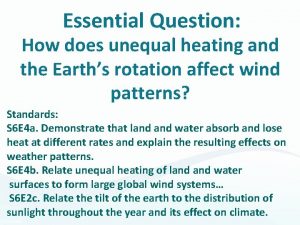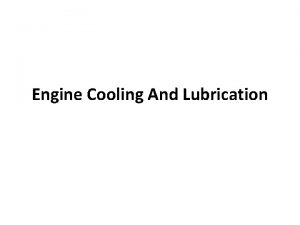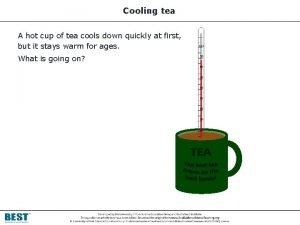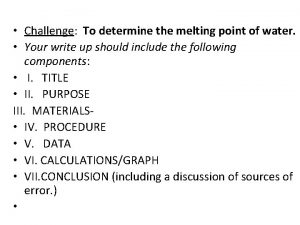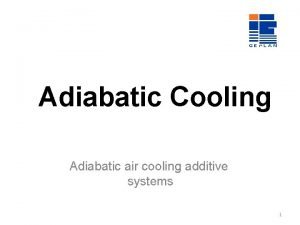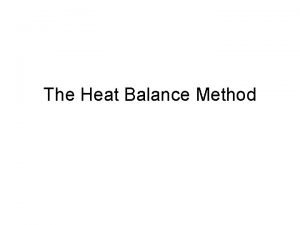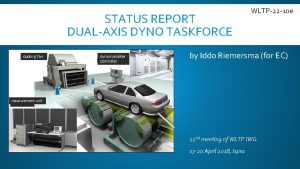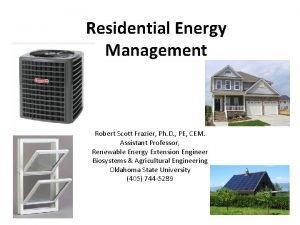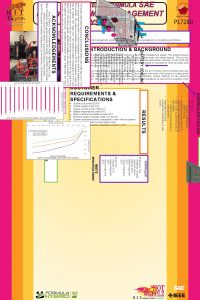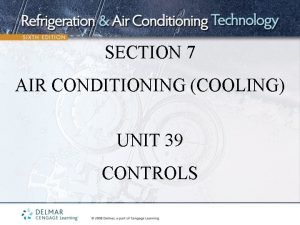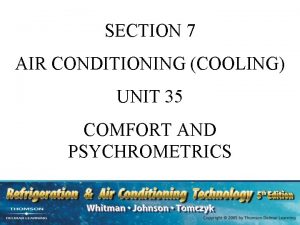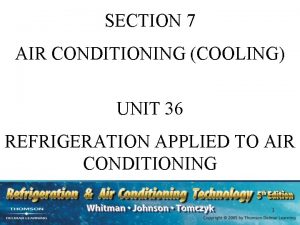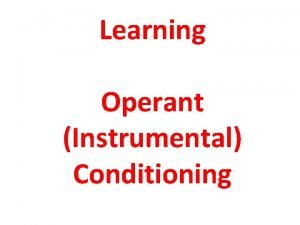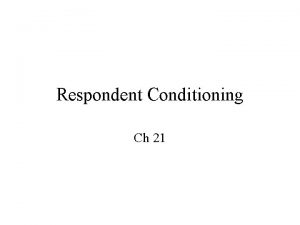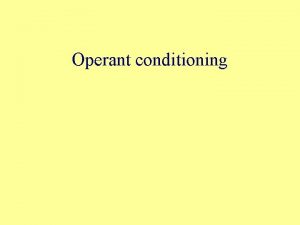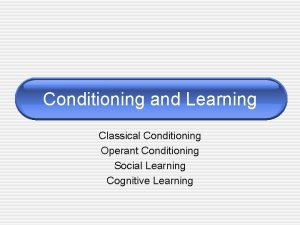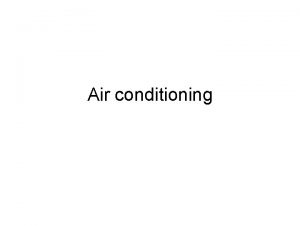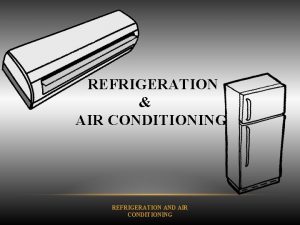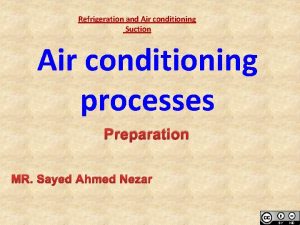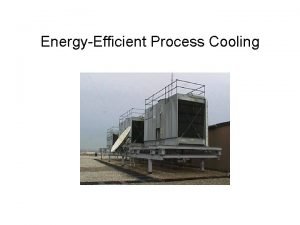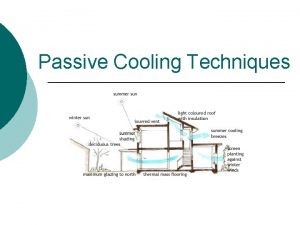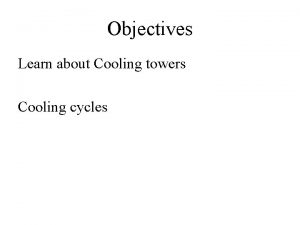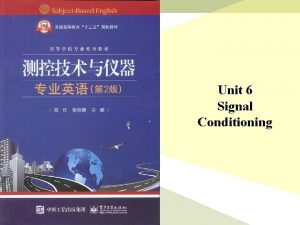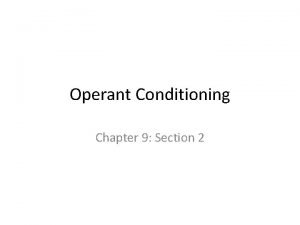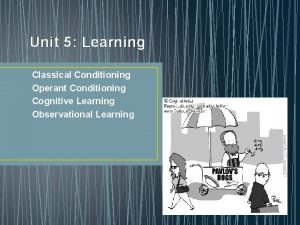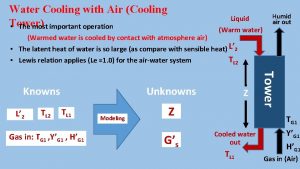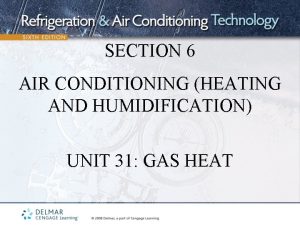SECTION 7 AIR CONDITIONING COOLING UNIT 37 AIR





























































- Slides: 61

SECTION 7 AIR CONDITIONING (COOLING) UNIT 37 AIR DISTRIBUTION AND BALANCE

UNIT OBJECTIVES After studying this unit, the reader should be able to • Describe propeller and centrifugal fans and blowers • Explain how to take air pressure measurements • Explain how to measure air quantities • List various types of air-measuring devices • Describe common types of motors and drive assemblies • Identify and describe various duct systems • Explain how air from the conditioned space returns to the air handler

CONDITIONING EQUIPMENT • Air has to be conditioned in most cases for us to be comfortable • Equipment includes cooling coil, heating device, device to add humidity, and device to clean air • Forced air systems use the same room air over and over again • Fresh air enters the structure by infiltration or by mechanical means

Return air from the occupied space Mechanical means to introduce ventilation Damper in fresh air duct Supply duct Air handler Fresh air from outside the structure

CORRECT AIR QUANTITY • The forced air system delivers the correct quantity of conditioned air to the occupied space • Different spaces require different air quantities • Same structure may have several different cooling requirements

100 cfm 200 cfm 50 cfm Living Room 9, 000 btu (cooling) 18, 000 btu (heating) 300 cfm 100 cfm 50 cfm 100 cfm 200 cfm

THE FORCED-AIR SYSTEM • Components that make up the forced-air system – The blower – Air supply system – Return air system – Grilles and registers • Occupants should not be aware if the system is on or off

Return air from the occupied space Supply registers Supply duct Air handler (blower)

THE BLOWER • Provides the pressure difference to force the air into the duct system, through the grilles and registers, and into the room • Typically 400 cfm of air must be moved per minute per ton of air conditioning • Pressure in the ductwork is measured in inches of water column (in. W. C) • Air pressure in the ductwork is measured with a water manometer

SYSTEM PRESSURES • Duct system is pressurized by three pressures – Static pressure – air pressure in the duct – Velocity pressure – pressure generated by the velocity and weight of the air – Total pressure • Static pressure plus velocity pressure equals total pressure

Probe located on the surface of the duct Airflow Duct Static pressure

Probe located in the duct, facing into the direction of airflow Total pressure

Velocity pressure Total pressure Static pressure Velocity pressure = Total pressure – Static pressure

AIR-MEASURING INSTRUMENTS FOR DUCT SYSTEMS • Velometer – Measures actual air velocity (how fast the air is actually moving in the duct) • Air volume in cfm can be calculated by multiplying the air velocity by the cross-sectional area of the duct in square feet • Pitot tube – Used with special manometers for checking duct pressure

PROPELLER FAN • Used in exhaust fan and condenser fan application • Will handle large volumes of air at low pressure differentials • Set into a housing called a venturi • The venturi forces airflow in a straight line from one side of the fan to the other • Makes noise and is used where noise is not a factor

Venturi Propeller fan

SQUIRREL CAGE OR CENTRIFUGAL FAN • Desirable for ductwork • Builds more pressure from the inlet to the outlet • Has a forward curved blade and a cutoff to shear the air spinning around the fan wheel • Very quiet when properly applied • Can be used in very large high-pressure systems

Centrifugal Blower End View of Squirrel Cage Blower Wheel

CENTRIFUGAL BLOWER HOUSING

TYPES OF FAN DRIVES • Belt-drive blowers have two bearings on the fan shaft and two bearing on the motor • Motor pulleys and fan motor pulleys can be adjusted to change fan speeds • Direct-drive motors use no pulleys or belts • Direct-drive motors can be multi-speed motors • Speeds can be changed by changing motor wire leads

BLOWER Belt-driven Assembly BOTH THE DRIVE AND DRIVEN PULLEYS MUST BE PERFECTLY ALIGNED MOTOR

DIRECT DRIVE MOTOR ASSEMBLY THE MOTOR AND THE BLOWER TURN AT THE SAME SPEED

THE SUPPLY DUCT SYSTEM • Distributes air to the terminal units, registers, or diffusers in the conditioned space • Duct systems – Plenum system – Extended plenum system – Reducing plenum system – Perimeter loop

THE PLENUM SYSTEM • Suited for a job where the room outlets are all close to the unit • Supply diffusers are normally located on the inside walls • Work better on fossil-fuel systems • Fossil-fuel supply air temperatures could easily reach 130°F

Plenum system Supply plenum Return duct Branch ducts

THE EXTENDED PLENUM SYSTEM • Can be applied to a long structure • This system takes the plenum closer to the farthest point • Called the trunk duct system • Ducts called branches complete the connection to the terminal units

THE EXTENDED PLENUM SYSTEM 100 cfm 200 cfm 50 cfm Living Room 9, 000 btu (cooling) 18, 000 btu (heating) 300 cfm 100 cfm 50 cfm 100 cfm 200 cfm

THE REDUCING PLENUM SYSTEM • Reduces the trunk duct size as branch ducts are added • Has the advantage of saving material and keeping the same pressure from one end of the duct system to the other

THE REDUCING EXTENDED PLENUM SYSTEM 100 cfm 200 cfm 50 cfm Living Room 9, 000 btu (cooling) 18, 000 btu (heating) 300 cfm 100 cfm 50 cfm 100 cfm 200 cfm

THE PERIMETER LOOP SYSTEM • Well suited for installation in a concrete floor in a colder climate • Warm air is in the whole loop when the furnace fan is running • Keeps the slab at a more even temperature • Provides the same pressure to all outlets

THE PERIMETER LOOP SYSTEM 100 cfm 200 cfm 50 cfm Living Room 9, 000 btu (cooling) 18, 000 btu (heating) 300 cfm 100 cfm 50 cfm 100 cfm 200 cfm

DUCT MATERIALS • Ductwork must meet local codes • For years, galvanized sheet metal was used exclusively • Other ductwork materials – Aluminum – Fiberglass ductboard – Spiral metal duct – Flexible duct

GALVANIZED STEEL DUCT • Gauge is the measurement of the thickness of galvanized steel duct • The gauge size means how many pieces of that material would need to be stacked together to make a one-inch stack • Metal duct can be round, square, or rectangular

JOINING SECTIONS OF GALVANIZED DUCT WITH SLIPS AND DRIVES Drive cleat Slip

JOINING SECTIONS OF GALVANIZED DUCT WITH SLIPS AND DRIVES Ends of drives are bent over to secure Slip

FIBERGLASS DUCT • Styles: Flat sheet or round prefabricated cut • Duct is normally 1 in. thick with aluminum foil backing • Special knives are used to make special cuts to turn duct board into ductwork • All duct seams should be stapled and taped

SPIRAL METAL DUCT • • Used more on large systems Comes in rolls of flat narrow metal Runs can be made at the job site Can be located within the occupied space for a more contemporary look

FLEXIBLE DUCT • Comes in sized up to about 24 in. in diameter • Some have a reinforced aluminum foil backing • Some come with vinyl or foil backing and insulation on it • Keep duct runs as short as possible • Has more friction loss inside it than metal duct • Flex duct should be stretched as tight as possible

Floor Register Return Damper Flexible Duct Supply

COMBINATION DUCT SYSTEMS • Metal trunk lines with round branch ducts • Metal trunk lines with flexible branch ducts • Ductboard trunk lines with round metal branch ducts • Ductboard trunk lines with flexible branch ducts • Round metal duct with round metal branch ducts • Round metal trunk lines with flexible branch ducts

DUCT AIR MOVEMENT • Branch ducts are fastened to the main trunk by a takeoff-fitting • The takeoff encourages the air moving the duct to enter the takeoff to the branch duct • Air moving in the duct has inertia, meaning it wants to move in a straight line • Using turning vanes will improve the air-flow around corners

Main supply duct Takeoff fitting

BALANCING DAMPERS • Used to balance the air in various parts of the system • Dampers should be located as close as practical to the trunk line • The trunk is the place to balance airflow • Handles allow the dampers to be turned at an angle to the airstream to slow the air down

Branch duct Damper in the open position Balancing damper in the closed position

DUCT INSULATION • A 15°F temperature difference from the inside of the duct to the outside of the duct is considered the maximum difference allowed before insulation is necessary • Metal duct can be insulated on the outside and on the inside • The insulation is joined by lapping it, stapling it, and taping it

BLENDING THE CONDITIONED AIR WITH ROOM AIR • • • When possible, air should be directed on the walls The diffuser spreads the air to the desired air pattern Cool air distributes better from the ceiling Place diffusers next to the outside walls How far the air will be blown from the diffuser into the room depends on the air pressure behind the diffuser and the style of the diffuser blades

THE RETURN AIR DUCT SYSTEM • Individual return air system will give the most positive return air • The return air duct is normally sized slightly larger than the supply duct • Central return systems are usually satisfactory for a onelevel residence • A path must be provided for the air to return to the central return • The return air grille should be around an elbow from the furnace

Central Return Supply plenum Return plenum One central return grill in the common area

INDIVIDUAL RETURN AIR SYSTEM S R

SIZING DUCT FOR MOVING AIR • Friction loss in ductwork is due to the actual rubbing action of the air against the side of the duct and the turbulence of the air rubbing against itself while moving down the duct • The smoother the duct’s interior surface is, the less friction there is • The slower the air is moving, the less friction there will be • Each foot of duct offers a known resistance to airflow

MEASURING AIR MOVEMENT FOR BALANCING • Air balancing is accomplished by measuring the air leaving each register • Measuring velocity of the duct in a cross section of the duct • Determine the cfm by using the formula: CFM = area in square feet x velocity in feet per minute

Cross-sectional area = 1 ft x 1 ft = 12” x 12” = 144 square inches = 1 foot Average air velocity is 400 fpm 144 in 2 / 144 in 2 = 1 ft 2 1 foot Air Volume (cfm) = 400 ft/min x 1 ft 2 = 400 cfm

Cross-sectional area = 18” x 18” = 324 in 2 / 144 in 2 = 2. 25 ft 2 18” Average air velocity is 400 fpm 18” Air Volume (cfm) = 400 ft/min x 2. 25 ft 2 = 900 cfm

THE AIR FRICTION CHART • Used by system designers to size ductwork and duct systems • Gives recommended duct sized and velocities for optimum performance • Can be used to troubleshoot airflow problems • Pressure drops in duct fittings have equivalent lengths • All lengths and equivalent lengths are added together to achieve the total

RESIDENTIAL DUCT SYSTEM • A 6 -in. round duct delivers 100 cfm to the space • An 8 -in. round duct delivers 200 cfm to the space • Common duct problems – – – Excessively long flexible duct runs Disconnected duct runs Closed dampers Collapsed flexible duct Loose insulation in the duct Blocked grills and/or registers

COMMERCIAL DUCT SYSTEMS • Each area has specifications regarding the required amount of airflow • Certified testing and balancing company to verify airflow • Flow hoods measure air volume at supply registers • Total airflow can be measured at the main duct • Common problems include dirty filters, partially closed dampers, and incorrect fan rotation

SUMMARY - 1 • Forced air systems use the same air over and over • Fresh air enters the structure by infiltration • Forced air systems deliver the correct quantity of conditioned air to the occupied space • Different spaces require different air quantities • Forced air systems are made up of the blower, supply duct system, return air system and supply registers or grilles

SUMMARY - 2 • Typically, 400 cfm of air must be moved per minute per ton of air conditioning • Pressure in the ductwork is measured in inches of water column (in. W. C) • Static pressure plus velocity pressure equals total pressure • Air volume in cfm can be calculated by multiplying the air velocity by the cross-sectional area of the duct in square feet

SUMMARY - 3 • Propeller fans are used in exhaust fan and condenser fan applications and can handle large volumes of air at low pressure differentials • Centrifugal blowers are used in duct systems • Motor drives can be direct or belt driven assemblies • The supply duct system can be configured as a plenum, extended plenum, reducing extended plenum or perimeter loop system

SUMMARY - 4 • Duct systems can be made of galvanized metal, aluminum, fiberglass duct board, spiral metal, flexible duct or a combination of different materials • Branch ducts deliver the proper amount of air to remote locations in the structures • Balancing dampers are used to help ensure proper airflow to the remote locations • The return air system can be configured as a central or individual return air system

SUMMARY - 5 • Friction in the duct slows the air flowing in it • Slower air experiences less friction • Air balancing ensures the proper amount of air is delivered to each supply register • CFM = velocity x cross sectional area • The friction chart is used to properly size duct systems
 Air cycle process
Air cycle process Operant conditioning vs classical conditioning
Operant conditioning vs classical conditioning Little albert experiment summary
Little albert experiment summary Variable ratio schedule of reinforcement
Variable ratio schedule of reinforcement Operant conditioning
Operant conditioning Fixed interval
Fixed interval Operant vs classical
Operant vs classical Classical vs operant conditioning
Classical vs operant conditioning Social learning theory vs operant conditioning
Social learning theory vs operant conditioning Classical conditioning vs operant conditioning
Classical conditioning vs operant conditioning Operant conditioning classical conditioning
Operant conditioning classical conditioning Denco unit
Denco unit Unit 36 hvac
Unit 36 hvac Introduction of refrigeration system
Introduction of refrigeration system Air conditioner cooling capacity
Air conditioner cooling capacity In order for clouds to form cooling air must be
In order for clouds to form cooling air must be Chapter 12 section 1
Chapter 12 section 1 Chapter 12 air section 1 what causes air pollution
Chapter 12 air section 1 what causes air pollution Hubungan air dengan tanah
Hubungan air dengan tanah 4 person elevator dimensions
4 person elevator dimensions Types of air conditioning system ppt
Types of air conditioning system ppt Trane psychrometric chart pdf
Trane psychrometric chart pdf Air washer psychrometric process
Air washer psychrometric process Trane air conditioning clinic
Trane air conditioning clinic Thermoacoustic
Thermoacoustic Ray's heating & air conditioning
Ray's heating & air conditioning Cooling load calculation software
Cooling load calculation software Air conditioning dip
Air conditioning dip Kayes credit card
Kayes credit card Dragon air conditioning
Dragon air conditioning Sea water air conditioning
Sea water air conditioning Cop of refrigerator
Cop of refrigerator Automotive heating and air conditioning 8th edition
Automotive heating and air conditioning 8th edition Hydraulic fluid conditioning
Hydraulic fluid conditioning Unit 6 review questions
Unit 6 review questions The case of the cooling corpse holmes answer key
The case of the cooling corpse holmes answer key Prince waste collection pays a yearly
Prince waste collection pays a yearly 410a charge chart
410a charge chart Electronic cooling methods
Electronic cooling methods Free cooling chiller
Free cooling chiller Oil immersion cooling
Oil immersion cooling Ocp liquid cooling
Ocp liquid cooling Heating and cooling load calculation example
Heating and cooling load calculation example Lubrication of couling systems
Lubrication of couling systems Closet cooling system
Closet cooling system Mounds of cooling brown and white
Mounds of cooling brown and white Heating curve of water
Heating curve of water Plate type exchanger
Plate type exchanger Vessel cooling
Vessel cooling Newton's law of cooling differential equation
Newton's law of cooling differential equation Unequal heating
Unequal heating Ess cooling system
Ess cooling system Ess cooling
Ess cooling Lubrication and cooling system
Lubrication and cooling system Cooling tea in english
Cooling tea in english Cooling curve worksheet answers
Cooling curve worksheet answers Double roof for cooling
Double roof for cooling Adiabatic cooling
Adiabatic cooling Ashrae heat load table
Ashrae heat load table Dyno cooling fan
Dyno cooling fan Solar cooling system
Solar cooling system Frazier heating and cooling
Frazier heating and cooling
